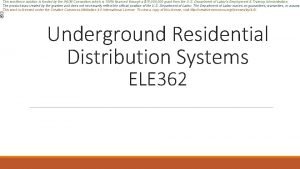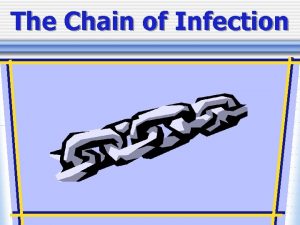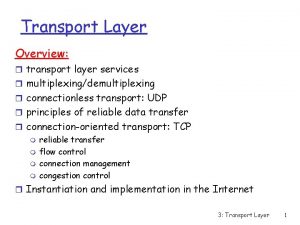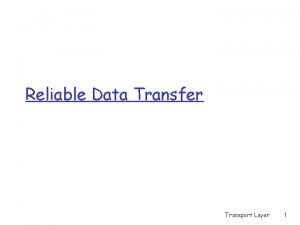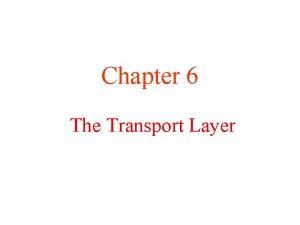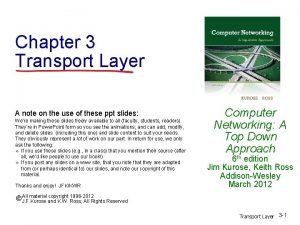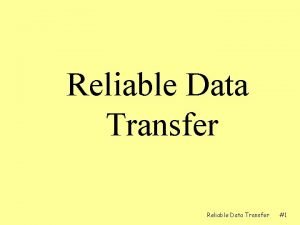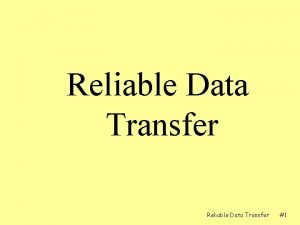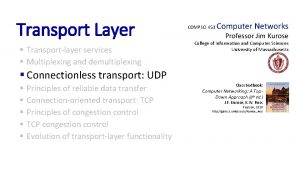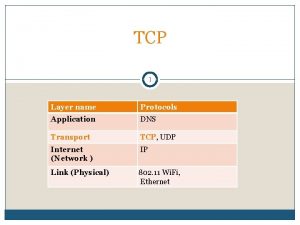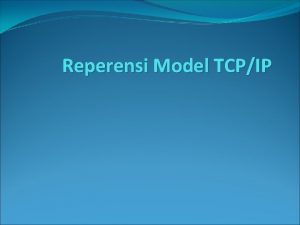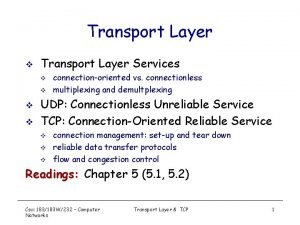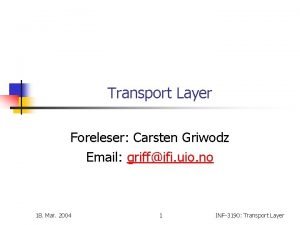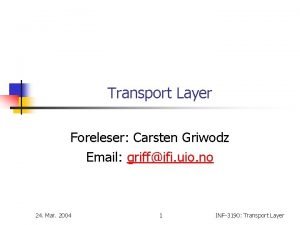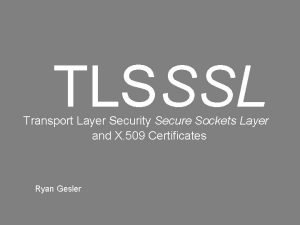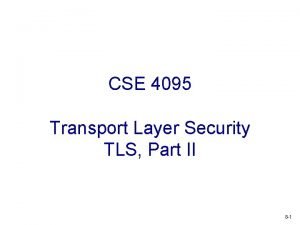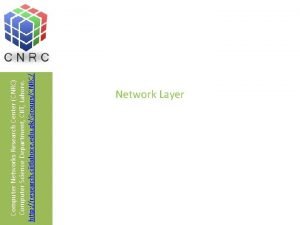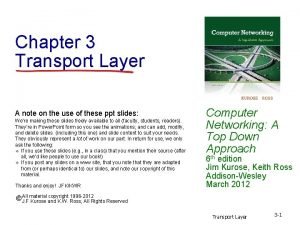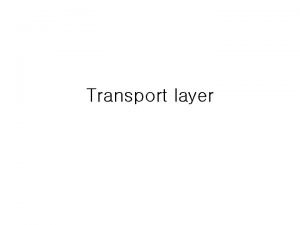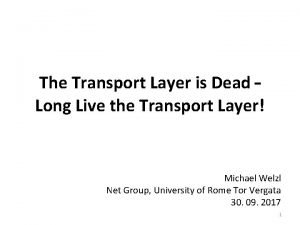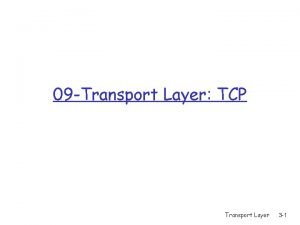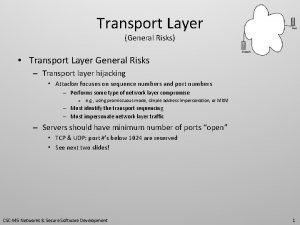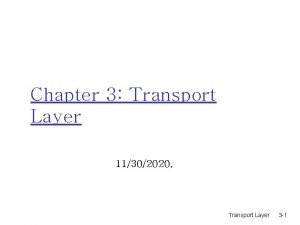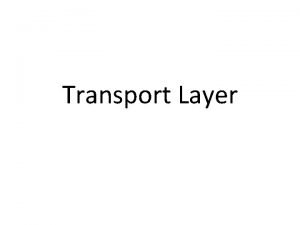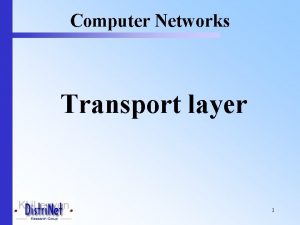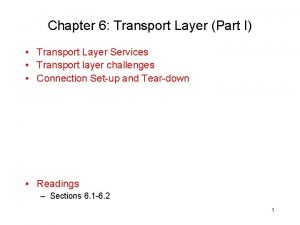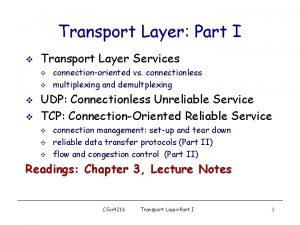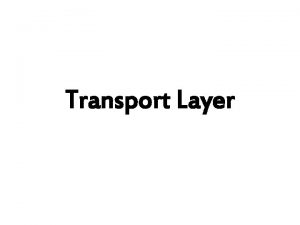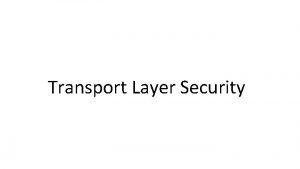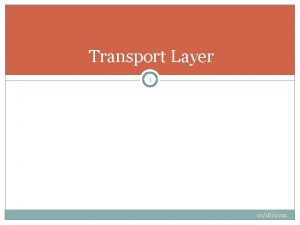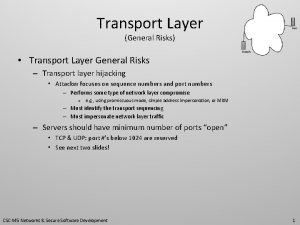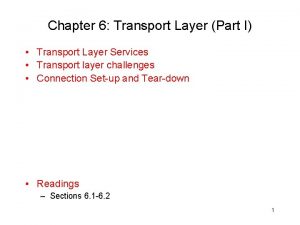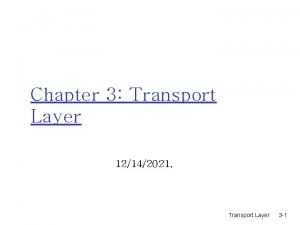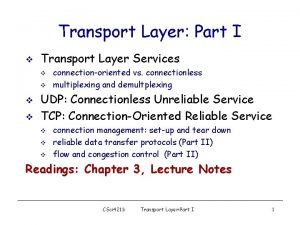The Transport Layer is Dead Long Live the











































- Slides: 43

The Transport Layer is Dead – Long Live the Transport Layer! Michael Welzl University of Oslo / University of Rome Tor Vergata 1 15. 01. 2018

– d a e D s i r e ! y r a e L y t a r L o t p r s o n p a s r n T a r e T h T e h t e v i L g n o L Layer 4 Michael Welzl University of Oslo / University of Rome Tor Vergata 2 15. 01. 2018

Wake up call • The transport layer is interesting again! – Somehow, (mostly US? ) industry is aware, but academia + (European? ) funding bodies don't recognize; only exception: MPTCP • Long list of new, interesting stuff! – HTTP/2 + QUIC; LEDBAT; Web. RTC (with RMCAT congestion controls) – Focus on low latency: Bufferbloat community => AQM algorithms: (FQ-)Co. Del, PIE and now also some Wi. Fi work; ECN: ABE, L 4 S • Why has transport "gone cold"? – No problem to solve, TCP works? not true! TCP = latency, complexity, bad fairness, bad interactions with delay-sensitive or non-greedy traffic, . . . – Changing TCP is frustratingly hard, else no chance to change anything? Not so true anymore! => story of this talk! 3

Outline 1. The "transport layer ossification" problem 2. The solution 1. IETF Transport Services (TAPS) WG 2. NEAT EC project (and software!) 4

Terminology Ossification Petrification 5

The Transport Layer is Dead. . (the problem) 6

The beauty ; -) of OSI. . . • A N-layer provides a service to the N+1 -layer – what's below the service interface is hidden • • Protocols inside layers are interchangeable • Transport layer (and above) should be especially easy to change! 7

Internet transport is ossified rified t e p Application Layer e. g. HTTP TCP Transport Layer node A UDP entity node B Applications expect precisely the behavior of TCP and UDP Routers expect to see precisely TCP or UDP (sometimes with even more limitations) 8

Transport layer development • Computer, 30 years ago • A program that sends data over the Internet, 30 years ago (using Berkeley sockets) 9

Transport layer development • Computer, today • A program that sends data over the Internet, today (using Berkeley sockets) 10

More than just sockets. . . • Previous example: Berkeley sockets – Today, applications use many different APIs from various libraries / middlewares • But these libraries/middlewares use sockets limited by the services of TCP and UDP 1. A reliable byte stream 2. Unreliable packet (“datagram”) transmission It’s a way of thinking about communication ! 11

. . . and it’s from the 80 s ! 1) Reliable byte stream, TCP 2) Datagram, UDP 12

What about. . . • Priorities? – Among your own flows, and between yours and others? • Careful “do not disturb anybody” background (“scavenger”) communication? • Intelligent use of multiple network interfaces? • Maybe using data even when a checksum fails? – Codecs can handle that, but UDP will throw away all your data • Using protocol features that yield lower latency? – Maybe trade latency against bandwidth? – Control the send buffer? 13

Example: unordered message delivery • Some applications can accept data chunks out of order, even when requiring reliability – TCP causes Head-Of-Line (HOL) blocking delay TCP receiver buffer Chunk 2 Chunk 3 Chunk 4 Chunk 1 App waits in vain! • Some protocols can deliver data out of order (e. g. SCTP) • If such a protocol is not available: fine to use TCP! • in-order delivery is correct! Just slower . . . BUT: unless an application asks for it, we can NEVER give it data in the wrong order. This service needs to be in ALL APIs ! (not just socket level) 14

. . . Long Live The Transport Layer! (the solution) 15

Solution part 1: A Standard. IETF Transport Services (TAPS) 16

TAPS Background • mid-2013, the time had come: LEDBAT, RTMFP, MPTCP, SPDY, Minion • Can we get some order into this chaos? • 1 year of community-convincing; 1 bar Bo. F; 2 Bo. Fs => TAPS chartered 24. 9. 2014 17 • History available at: https: //sites. google. com/site/transportprotocolservices/

How TAPS wants to solve the problem • Unordered reliable message delivery is only one example • What is the minimum set of transport services. . . – from the services that IETF transport protocols offer . . . that we “must” make available everywhere for them to become usable? • Once we know that, we can specify how to implement a TAPS system 18

TAPS charter: planned outcomes 1. List of services provided by today’s transports 2. List: subset of services that systems supporting TAPS will provide + guidance on choosing among available mechanisms and protocols 3. Experimental spec: mechanisms to provide the services identified in item 2 (“This document will explain how to select and engage an appropriate protocol and how to discover which protocols are available for the selected service between a given pair of end points. Further, it will provide a basis for incremental deployment. ”) 19

Bottom-up method to derive a minimum set of transport services • IETF Transport Services (TAPS) Working Group 1. Survey of services provided by transport protocols – RFC 8095 (54 pages) 2. In-depth analysis of 30+ RFCs: TCP, MPTCP, UDPLite, SCTP, LEDBAT (RFCs-to-be 8303 & 8304 ~ 79 pages) 3. Derivation of a minimum set: from 2), keep only services that require application-specific knowledge and do not prohibit falling back to TCP / UDP; resolve some resulting peculiarities (1 Internet-draft, 53 pages) 20

Fall-backs enable one-sided deployment New App New API New App New Protocol X New App New API TCP UDP New API Several Protocols Current App Sockets TCP Current App Sockets UDP 21

Result (latest version): high-level view Note: assume TCP fall-back only (assuming UDP fall-back limits this list) 1. Flow creation and flow grouping – Most configuration features only configure a group (e. g. , can’t configure timeout for an SCTP stream only) – Should use configuration early, ideally before connecting 2. Send-before-connect – Could also be implemented as a parameter to “connect” – Specify “idempotent data” for extra-fast transmission (TFO) 3. Limited connect / listen / close / abort semantics (support UDP, or transparently use streams) – Connect may not invoke accept! – No half-closed connections 22

Result (latest version): high-level view /2 • Be informed about sender buffer running dry – Late decision about choice of data to send • Configure: per-flow priorities, network-wide priorities (DSCP), timeout, authentication, checksums • Some queries, e. g. related to packet sizes • Send messages, receive bytestream – Messages stay intact, but may be reordered or dropped (configured by sender) – Receiver must be aware (detect boundaries) 23

Moving to a system specification. . . • TAPS charter item 3: currently various documents / proposals – post-sockets: TLS features, connection migration, various other extras, related to Apple's soon-to-be -shipped code – guidelines for TAPS systems, security survey – NEAT project outputs (happy eyeballs, API, . . ) – socket intents (mostly focused on interface choice) 24

Solution part 2: Code. The project (and software) 25

What does NEAT offer? • A user-space library for efficient e 2 e network Internet comm. , designed to be easy to use – Think of it as "TAPS minimum set ++" • Easy, platform-independent access to the features of TCP, MPTCP, SCTP, UDP-LITE and more researchy things via a callback-based API – Policy system to control everything via json files • One-sided deployment possible, can do fall-backs to TCP or UDP, can talk to native peers (e. g. TCP, SCTP, even Web. RTC browser!) 26

Internals: sequence of events in NEAT 27

Happy Eyeballs 28

More deployment considerations • “Application” could be a library or middleware – e. g. , pub-sub doesn’t need 100% reliability => interesting research possibilities ("networking meets distributed systems") – would only exploit a subset of TAPS capabilities, but re-compiling an app with the new middleware version would make the app use TAPS • Related NEAT development: NEAT socket API – Run legacy applications over NEAT using "withneat commandname params" – Benefit from: policy settings; transparent SCTP-stream-mapping 29

Conclusion • We have: – IETF TAPS – Apple – The NEAT project, including Mozilla and the main SCTP developers • . . all working towards a real transport layer – New flexibility, new research possibilities • Please join the NEAT effort – download, test, extend and play! 30

Stuff ! • TAPS: – https: //datatracker. ietf. org/wg/taps/ • NEAT: – http: //www. neat-project. org – https: //github. com/NEAT-project/neat – "NEAT: A Platform- and Protocol-Independent Internet Transport API", IEEE Communications Magazine 55 (6), 2017. – "De-ossifying the Internet Transport Layer: A Survey and Future Perspectives", IEEE Communications Surveys & Tutorials 19(1), First quarter 2017. 31

Questions, comments? 32

Backup slides 33

Sending messages, receiving a bytestream • Can we make this combination work? – Be compatible to TCP but still benefit from messages? • Alternative not very attractive: always telling an application “sorry, you only get a stream here” is not much different than saying “sorry, use TCP instead” – Let’s minimize # hoops an app developer has to jump through • Message-oriented TCP apps already frame their data – Unnecessary to repeat this in transport layer – Requirement to tell receiver app “here is your complete message” creates a major limitation and is often unnecessary 34

Application-Framed (AFra-)Bytestream • Normal TCP-like bytestream API – Optional: some additional information provided by sender app • Sender app: hands over a stream of bytes, informs transport about frame boundaries and requirements (order, reliability, . . ) – Delimited frames stay intact, in order – More relaxed rules possible between frames – Delimiters assumed to be known by application • Receiver app: receives stream of bytes – App-level delimiters turn it into messages • TCP = special case: no delimiters used – Can talk to “normal” TCP applications on both sides 35

Unordered message delivery: SCTP Sender app Msg 3 Receiver app Msg 2 Msg 3 App-defined header. Could also be e. g. implicit knowledge about size Msg 1 API Msg 1 • Inform where frame ends • Inform where frame begins • Configure: “unordered” Block 3 Block 2 Msg 2 App knows how to identify messages Just a byte stream! API Block 1 Block 3 Block 1 36

Unordered message delivery: TCP Sender app Msg 3 Receiver app Msg 1 Msg 2 Msg 1 Msg 3 API App knows how to identify messages • Inform where frame ends • Inform where frame begins • Configure: “unordered” … TCP just ignores this! Block 3 Block 2 Just a byte stream! API Block 1 Block 3 Block 1 37

Unreliable unordered msg delivery: SCTP Sender app Msg 3 Receiver app Msg 2 Msg 3 Msg 2 Msg 1 API • Inform where frame ends • Inform where frame begins • Configure: “unreliable, unordered” Block 3 Block 2 App knows how to identify messages Just a byte stream! API Block 1 Block 3 38

Unreliable unordered msg delivery: TCP Sender app Msg 3 Receiver app Msg 1 Msg 2 Msg 1 Msg 3 API • Inform where frame ends • Inform where frame begins • Configure: “unreliable, unordered” … TCP just ignores this! Block 3 Block 2 Block 1 App knows how to identify messages Just a byte stream! API Block 1 Block 3 39

Unreliable message delivery: SCTP, large messages Msg 3 Sender app Receiver app Msg 2 Msg 1 API • Inform where frame ends • Inform where block begins • Configure: “Unreliable” Block 3 Block 2 API Block 1 Packets 40

Unreliable message delivery: SCTP, large messages Sender app Receiver app Msg 2 App knows how to identify messages Just a byte stream! API Block 3 Block 2 API Block 1 SCTP Packets 41

Init: example decision tree Avoids, e. g. : 1) choose UDP 2) app asks for reliability - Will you need some form of reliability? Yes: SCTP or TCP can be used. - Is any of the following useful to the application? * Choosing a scheduler, choosing priorities * Configurable message reliability * Unordered message delivery * Request not to delay message SACKs Yes: SCTP is preferred. No: - Is any of the following useful to the application? * Hand over a message to reliably transfer (possibly multiple times) before connection establishment * Suggest timeout to the peer * Notification of Excessive Retransmissions (early warning below abortion threshold) * Notification of ICMP error message arrival Yes: TCP is preferred. No: SCTP and TCP are equally preferable. No: all protocols can be used. - Is any of the following useful to the application? * Specify checksum coverage used by the sender * Specify min. checksum coverage required by receiver Yes: UDP-Lite is preferred; No: UDP is preferred. 42

NEAT architecture 43
 The king is dead long live the king
The king is dead long live the king The book is dead long live the book
The book is dead long live the book Secure socket layer and transport layer security
Secure socket layer and transport layer security Secure socket layer and transport layer security
Secure socket layer and transport layer security Secure socket layer and transport layer security
Secure socket layer and transport layer security Secure socket layer and transport layer security
Secure socket layer and transport layer security Juan soriano la niña muerta; the dead girl; dead infant
Juan soriano la niña muerta; the dead girl; dead infant Long and short
Long and short Once upon a time there lived a
Once upon a time there lived a Dead front vs live front transformer
Dead front vs live front transformer Better a live donkey than a dead lion meaning
Better a live donkey than a dead lion meaning Plantlike organisms that live on dead organic matter
Plantlike organisms that live on dead organic matter Từ ngữ thể hiện lòng nhân hậu
Từ ngữ thể hiện lòng nhân hậu Pigmented layer and neural layer
Pigmented layer and neural layer Git layers
Git layers Layer 6 presentation layer
Layer 6 presentation layer Layer 2 e layer 3
Layer 2 e layer 3 Layer-by-layer assembly
Layer-by-layer assembly Layer 2 vs layer 3 bitstream
Layer 2 vs layer 3 bitstream Transport layer handles multiplexing and demultiplexing
Transport layer handles multiplexing and demultiplexing Layer 2 transport
Layer 2 transport Principles of reliable data transfer in transport layer
Principles of reliable data transfer in transport layer Crash recovery in transport layer geeksforgeeks
Crash recovery in transport layer geeksforgeeks Upward multiplexing and downward multiplexing
Upward multiplexing and downward multiplexing Chapter 3 transport layer
Chapter 3 transport layer Wireless transport layer security
Wireless transport layer security Tcp reliable data transfer
Tcp reliable data transfer Reliable data transfer in transport layer
Reliable data transfer in transport layer Multiplexing and demultiplexing in transport layer
Multiplexing and demultiplexing in transport layer Dns transport layer protocol
Dns transport layer protocol Transport layer
Transport layer Mobile transport layer
Mobile transport layer Transport layer
Transport layer Tcp connection management finite state machine
Tcp connection management finite state machine Transport layer
Transport layer Transport layer
Transport layer Transport layer
Transport layer Iup handshake
Iup handshake Design goals of transport layer protocol
Design goals of transport layer protocol Multiplexed transport layer security
Multiplexed transport layer security Transport layer
Transport layer Transport layer ppt
Transport layer ppt Transport layer.
Transport layer. Tcp segment header
Tcp segment header









